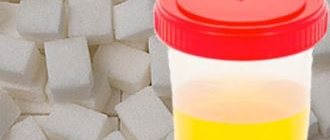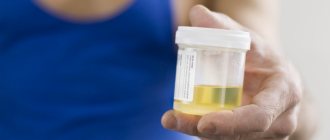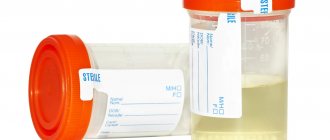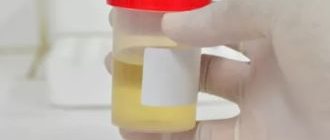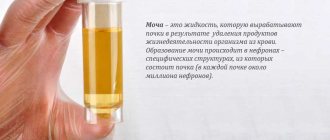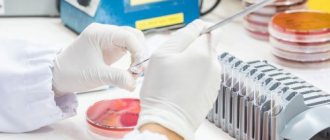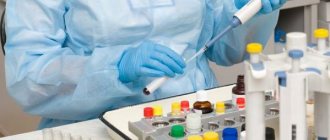Protein norm
Protein excretion in urine is not normal. Normally, urine contains only traces of this substance. Indeed, during filtration in the kidneys, the glomerular system prevents protein from entering the urine. However, this only applies to molecules of high molecular weight, but proteins with small molecular weights can pass through such a barrier. In the proximal tubules, the predominant percentage of proteins is absorbed into the blood, only a small part is excreted.
The excretion of proteins in urine indicates a malfunction of the mechanism of the glomerular filtration system at the site of identification of charge or volume in protein molecules, which can become an initiating factor for nephrotic syndrome. Sometimes protein appears in urine due to impaired reabsorption due to autoimmune diseases, poisoning, and drug intoxication. The increased protein content in urine can also be explained by a high level of protein particles in the blood due to massive muscle destruction, in myeloma, in the case of hemolysis.
It turns out that the determination of traces of protein in urine can be without pathology. But this value should not exceed more than 0.033 grams per liter in the morning portion of urine. This phenomenon occurs during heavy physical exertion, when consuming large amounts of protein foods, and during fever. Such proteinuria does not require therapeutic measures.
There is proteinuria of a pathological nature, the amount of protein exceeds the above value. This phenomenon occurs with glomerulonephritis, pyelonephritis, cystitis, prostatitis, and nephropathy of pregnancy. In this situation, it is very difficult to estimate the actual amount of protein that is lost in 24 hours based on just one urination. That is why a daily urine test for protein is prescribed.
Basic recommendations
Daily urine for protein must be collected correctly, otherwise the data will be inaccurate. The use of certain medications and vitamin complexes can lead to distorted results, so their use is stopped one day before.
It is necessary to collect the liquid correctly to obtain reliable analysis results. If the container was purchased at a pharmacy, then no additional measures need to be taken; however, containers taken from home must be thoroughly washed and sterilized.
This collection is carried out independently at home, and it is also possible under conditions of stationary observation. Before collecting, you must wash with warm water and baby soap. Women are prohibited from getting tested during menstruation. If curdled or white vaginal discharge appears, a gauze cloth should be placed on the utensil to prevent foreign discharge from entering the urine.
Urine is collected in the morning on an empty stomach, while urine is collected only after a few seconds of urination. Since 24-hour urine collection is carried out accurately, it is recommended to record the time of the first collection so that it coincides with the last. It is also important to properly store the collected material, which is best stored at temperatures from +4 to + 9. The container with the analysis is stored with a tightly closed lid to prevent opening and entry of foreign bodies.
All liquid during the day must be placed in one container, since its volume is as important as the presence of protein traces. The entire collection is submitted for research, but only part of it can be used for analysis. A completely healthy person produces and excretes up to 2 liters per day. urine. The total volume is affected by the amount of water drunk per day, external temperature, physical activity, and kidney health. In the heat of summer, some of the fluid is removed from the body through sweat, so the volume of urine may be less. Also, during physical activity, a lot of sweat can be produced.
The norm of proteins in urine in children
Children without diseases should also not have protein molecules in their urine. But the level of protein in urine up to 0.035 g is also considered normal. per liter Such numbers may arise for physiological reasons; they are not a reason to panic. A protein content of more than one gram per liter indicates a moderate degree of increase, and more than three indicates a high degree. High and moderate degrees require a detailed approach to diagnosis.
The principle of urine collection in children is the same as in adults.
Types of proteinuria
The main factor influencing the appearance of protein compounds in urine is problems in the absorption of this substance. Proteinuria is distinguished:
- Canalicular. In some diseases, protein absorption is impossible or difficult.
- Glomerular. In this case, protein molecules are not retained and are excreted along with the liquid. This phenomenon is typical for the following pathologies: pyelonephritis, kidney damage from toxins, glomerulonephritis.
- Extrarenal. There are damage to the urinary tract, characteristic of urethritis, colpitis and cystitis.
To determine the type of proteinuria, microscopic examination is used. Further, if necessary, the doctor prescribes other types of examinations, including ultrasound, magnetic resonance imaging and other hardware methods.
24-hour urine test
When the general analysis reveals protein molecules, the doctor will prescribe an examination that allows you to take into account the daily protein in the urine. This necessity is dictated by the fact that a general analysis cannot be done; it is impossible to take into account low molecular weight molecules. In a person without pathology, the daily loss of protein is 45-75 mg in 24 hours. Proteinuria is a loss of more than 130 mg per day.
Depending on the numbers of protein excreted in urine, proteinuria is divided into:
- Microalbuminuria (from 25 to 300 mg is excreted).
- Mild proteinuria (loss of 300 mg to one gram per 24 hours).
- Medium type (from one to three grams).
- Massive appearance (over three grams).
Proteinuria is also divided according to the reason that caused it:
- glomerular (against the background of increased permeability of the kidney filter due to glomerulonephritis, pyelonephritis, severe intoxication, impaired blood supply to the renal tissue);
- tubular (when normal protein absorption changes, usually with amyloidosis);
- extrarenal (if the urinary tract and genital organs are damaged).
To determine the type of proteinuria, urine microscopy is performed.
If there are a lot of leukocytes and red blood cells in the urine, then inflammation of the urinary tract occurs. In their absence, we can talk about the renal genesis of proteinuria.
Types of daily diuresis
There are many classifications of diuresis based on the time of day, the nature of urine excreted, its volume, the time during which diuresis is recorded, etc.
Based on the amount of urine excreted per day, there are:
- Polyuria. Increased amount of urine excreted. May be caused by kidney damage or pathology of the endocrine system, excessive drinking, high blood pressure, during psychosis;
- Oliguria. Decreased urine production. Manifests itself with low blood pressure, intoxication, heavy sweating, shock, depression, acute intestinal infection;
- Anuria. Complete absence of urine or less than 50 ml per day. It is a life-threatening condition. Develops during preagonal conditions, acute renal failure, shock and other life-threatening disorders.
Depending on the time of day it happens:
- Daytime diuresis;
- Nocturnal diuresis.
Normally, daytime diuresis prevails over nighttime diuresis in a ratio of 3:1 – 4:1. A change in the direction of nocturnal diuresis is usually characteristic of endocrine pathology, but can be a sign of mental disorders.
According to the nature of excreted urine, it can be:
- Water diuresis. The concentration of substances dissolved in the urine is extremely low, and its total volume exceeds the norm. Develops with increased physical activity, increased fluid intake, diabetes, while taking diuretics, and renal failure.
- Osmotic diuresis. With an increased amount of urine excreted, it contains a high concentration of excretory substances (secondary metabolic products). Occurs with diabetes mellitus, glomerulonephritis, taking osmotic diuretics, poisoning with poisons or toxins.
- Antidiuresis. Characterized by a small amount of urine with a high concentration of excreted compounds. It can develop due to low fluid intake in the body, low blood pressure, during conditions that threaten the patient’s life, in stressful situations, and during acute intestinal infection.
Almost every medical concept and indicator has variations. The same applies to the topic at hand. First of all, a distinction is made between daytime and nighttime diuresis. The first, as a rule, makes up two thirds of the total daily volume.
- Water. In this case, the urine contains a small amount of active substances. This manifestation can serve as a sign of diabetes insipidus, tick-borne encephalitis and some renal pathologies. But quite often water diuresis is caused when the water balance is disturbed. The patient may be drinking a lot of fluids, especially in hot weather.
- Diuresis is osmotic. There is a large amount of urine with a high content of various active substances.
- Antidiuresis. This type is characterized by a small amount of urine, which is excessively saturated with various substances.
The last two types of diuresis in adults and children indicate the presence of pathologies in the functioning of the kidneys. Monitoring of such patients should be increased. Plus, it is necessary to conduct a more thorough examination to identify the factors that led to the imbalance of water balance.
Depending on the time of day, daytime and nighttime diuresis are distinguished. If there are no disruptions in the body, the ratio of daytime to nighttime diuresis is 3:1 or 4:1.
Under the influence of certain diseases, this indicator increases in favor of night diuresis. This condition is called nocturia. A person is forced to interrupt sleep due to a constant urge to urinate. This leads to lack of sleep and decreased performance.
Based on the size of the released substances capable of binding water molecules and the volume of liquid, 3 types of diuresis are distinguished:
- water. The total concentration of dissolved substances decreases. If there are no pathologies, this condition is explained by an increase in the amount of fluid consumed. Water diuresis is one of the symptoms of true and renal diabetes insipidus and tick-borne encephalitis. In kidney pathologies, this condition is characteristic of the phase of edema resolution or is associated with a disorder of water and electrolyte metabolism;
- osmotic. Due to the increased concentration of sodium and chlorine, more liquid is released. This type of diuresis is characterized by excessive loading of the proximal nephron - one of the parts of the kidneys - with biologically active substances. These include: urea, glucose, simple sugars. Under the influence of these compounds, reabsorption is reduced. Because of this, an excess amount of fluid enters the kidneys. Osmotic diuresis develops in chronic renal failure and diabetes mellitus. It is provoked by taking medications that remove fluid. Osmotic diuretics include: Mannitol, Sorbitol, Potassium Acetate, etc.;
- antidiuresis is a condition opposite to the osmotic type. With it, little urine is released, the concentration of active substances is high;
- forced is a detoxification method, which is based on the accelerated removal of toxins from the body by increasing the volume of urine produced. This effect is achieved by simultaneously introducing a large volume of fluid into the body and prescribing diuretics.
DETAILS: Squamous Epithelium in the Urine of a Child: 3 Main Types, Normal
Of great importance is not only the fact of how much urine a person excretes per day, but also the quality indicators of biological fluid and the content of osmotic substances in it. Based on this, daily diuresis is divided into the following types:
- aqueous - the total volume of urine excreted is exceeded, but the concentration of biochemical compounds is low (found in people who like to drink a lot of carbonated drinks, juices, mineral water);
- osmotic - the daily amount of urine is high, but at the same time the biological fluid is oversaturated with useful and harmful substances (a similar clinical picture is typical for people with metabolic disorders);
- antidiuresis - the volume of urine that is excreted from the body is reduced to a minimum level, and the concentration of osmotic substances remains very high, which is often found in people who have undergone surgery on internal organs.
The type of diuresis formed during the day is determined during laboratory tests of collected urine, and is also taken into account by the attending physician when making a diagnosis and prescribing a therapeutic course.
If deviations from the norm in the daily volume of urine are detected, it is necessary to establish the cause of the pathology as quickly as possible in order to avoid complications and negative consequences for the body. The study of biological material, which was collected over 24 hours, allows us to establish the presence of pathologies of the genitourinary system such as oliguria, polyuria and anuria.
Daily diuresis can be divided into nighttime and daytime. The second predominates over the first in a healthy person. If this does not happen, then the pathology is called nocturia.
Based on the amount of urine excreted, there are:
- polyuria (the volume of urine excreted exceeds three liters);
- oliguria (urine excreted 500 ml or less);
- anuria (urination of no more than 50 ml per day).
The amount of urine produced depends on the fluid consumed
In addition to quantitative indicators, indicators of the qualitative nature of urine composition are also important. Based on the concentration of released osmotically active substances, they are distinguished:
- osmotic diuresis (a lot of urine containing many active substances is excreted);
- water diuresis (few active substances and a lot of urine);
- antidiuresis (many osmatic substances and little urine).
How to collect urine?
How to properly collect daily urine? Before taking such an examination, appropriate preparation must be carried out. The day before the expected analysis, you need to exclude alcoholic beverages from your diet, as well as fatty, spicy, and sweet foods. In addition, stop taking aspirin, diuretics, and vitamins. Daily urine should not be collected from women during menstruation; this is possible only if absolutely necessary.
For the fair half of humanity, there is an important recommendation that should be followed, namely: before urinating, you should use a hygienic sponge
Urine is collected in a special container, which can be purchased at a pharmacy. In the absence of one, it is permissible to collect it in a three-liter jar. It is recommended to buy one large container and several small containers, this will make it easier to follow the rules for collecting urine. After each urination, urine is poured from a small container into a larger one. The container must be clean, without traces of disinfectants. It should also be dry.
Before each urination, you need to toilet the external genitalia. Be sure to use soap, which is then washed off with water. Afterwards, the organs should be blotted with a clean napkin. Urine is not collected during the first urination, but the time of this act is noted. Subsequently, all urine is collected in the same container.
After each act of urination, the jar is tightly twisted and hidden in the refrigerator. The storage temperature should fit into the range from four to eight with a plus sign. Next, at the end of the collection, it is necessary to note the time at which it was completed, as well as the amount of urine. You must also stick a paper with your data on the jar, indicate the start time of collection and its end. The collected material should be shaken and about one hundred milliliters of urine should be poured into another container for general clinical analysis. After this, submit the biological material to the laboratory.
How is the urine collection procedure performed?
To obtain complete information, the patient will need to collect and submit urine. And it doesn’t matter whether it’s an analysis for sugar or protein. The most important thing is to assign the patient urine collection and provide instructions, since a special container or vessel should be prepared for a correctly collected analysis. Moreover, if the analysis is taken for sugar and protein, then one vessel will be required, since the analysis has a common structure.
It is necessary to collect a urine test per day to find out:
- when diabetes is suspected;
- there are disturbances in the functioning of the urinary organs;
- suspicion of the presence of stones or sand in the kidneys;
- to determine the presence of inflammation or tumor in the kidneys.
It is necessary to collect daily urine during pregnancy, when it is necessary to check the functioning of the woman’s body.
During the day, you can collect high-quality diuresis, in which quantitative indicators of the presence of protein and sugar will be identified and assessed.
What does such an analysis provide?
Based on such an examination, the presence of a number of pathologies can be assumed. But it is worth noting that an accurate diagnosis requires a more detailed and thorough study using other laboratory and instrumental techniques. The presence of protein in the urine may indicate:
What does protein in urine mean?
- decompensation of diabetes mellitus;
- kidney failure;
- amyloidosis;
- cardiac ischemia;
- connective tissue diseases;
- lipoid nephrosis;
- Fanconi syndrome;
- glomerulonephritis and pyelonephritis;
- hypertension;
- malignant diseases.
Also, protein excretion in urine is possible in case of diseases of the respiratory system and gastrointestinal tract. Also of great importance is the so-called selective proteinuria. In this case, a certain type of protein is released, usually albumin. If this type of protein is elevated in the urine, then pathology of the kidneys or the cardiovascular system can be assumed.
Causes of High Protein Levels
What is the reason for the increase in protein compounds? To date, many diseases have been identified that can cause proteinuria. These include:
- systemic connective tissue pathologies (lupus);
- type diabetes;
- multiple myeloma;
- progressive hypertension;
- kidney diseases;
- malignant neoplasms.
Also, a similar effect occurs due to chemotherapy procedures; mechanical injuries; burns of varying severity; intoxication of the body; hypothermia.
Protein penetrates into the blood in three ways. The first involves increased blood flow; this phenomenon does not require treatment. The second is damage to the basement membrane. The enlargement of its openings promotes the release of proteins into the tubules and further into the urine. In the third case, the filtration surface is fine, the problem is localized in the kidney tubules, which do not return the protein required to maintain the body normally.
Analysis in pregnant women
Since women in this position significantly increase the load on their kidneys, they often experience swelling, shortness of breath, weakness, and sudden weight gain. In such cases, the doctor suggests collecting daily urine. This analysis should be done once every 48 hours. If the protein is detected, then hospital therapy is recommended for the pregnant woman. Daily urine protein is also often done during the second screening during pregnancy (this is 22-24 weeks of gestation). This is a kind of preventive measure for the early detection of pathology.
